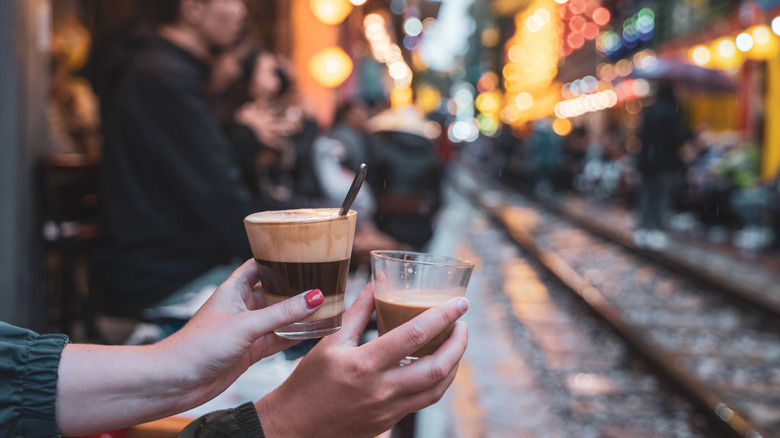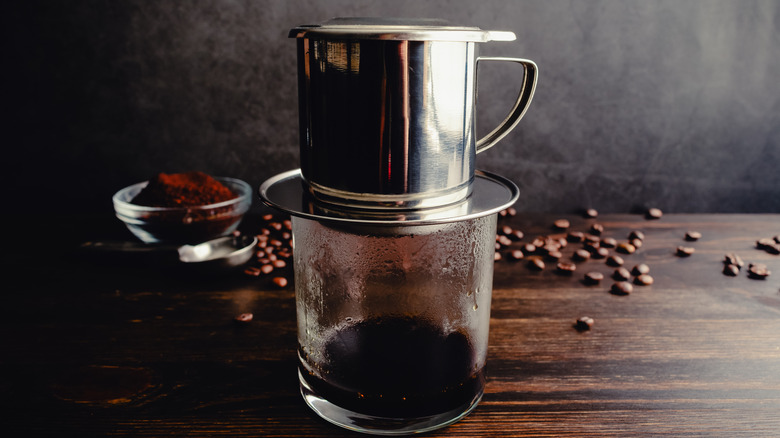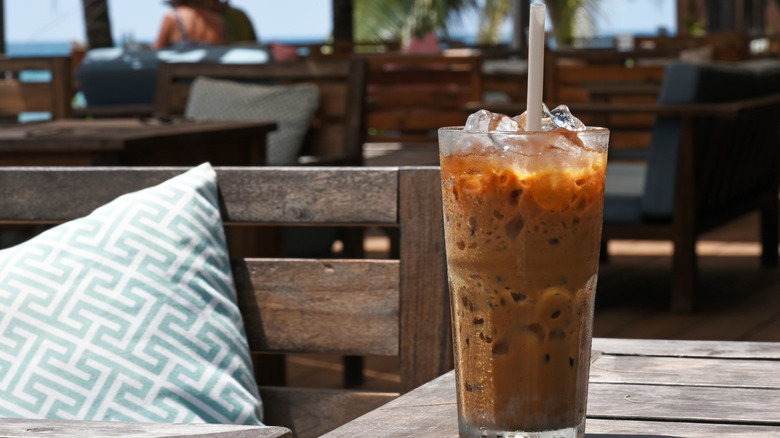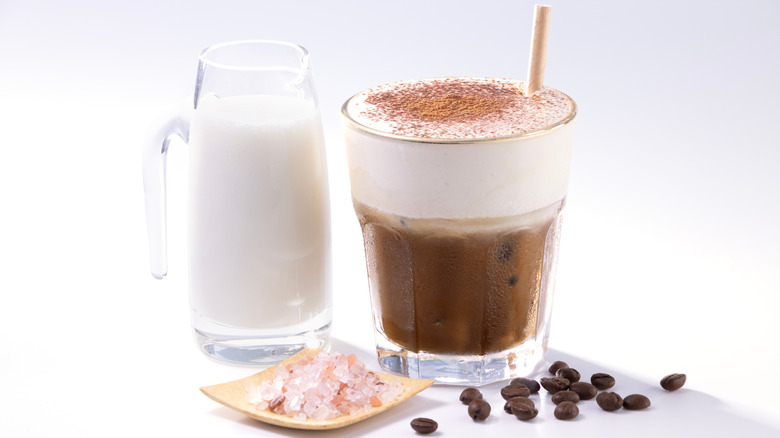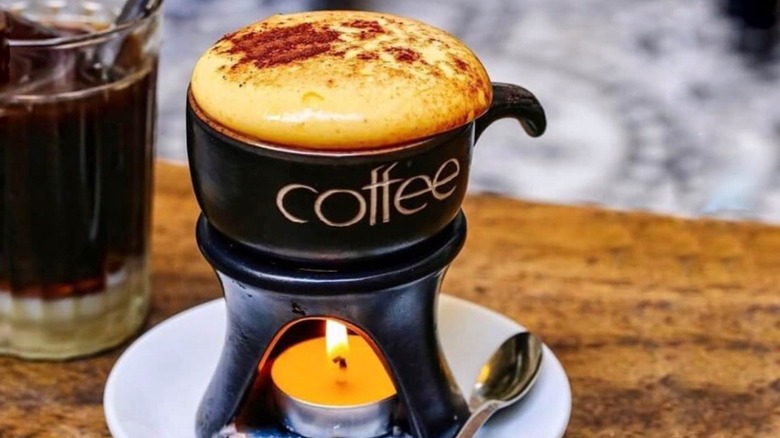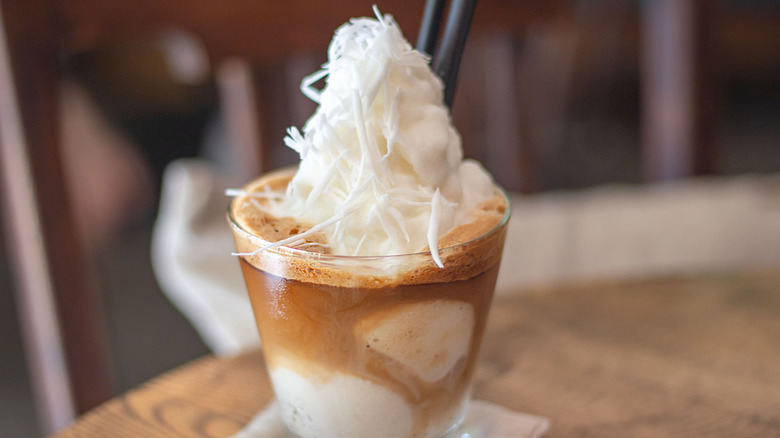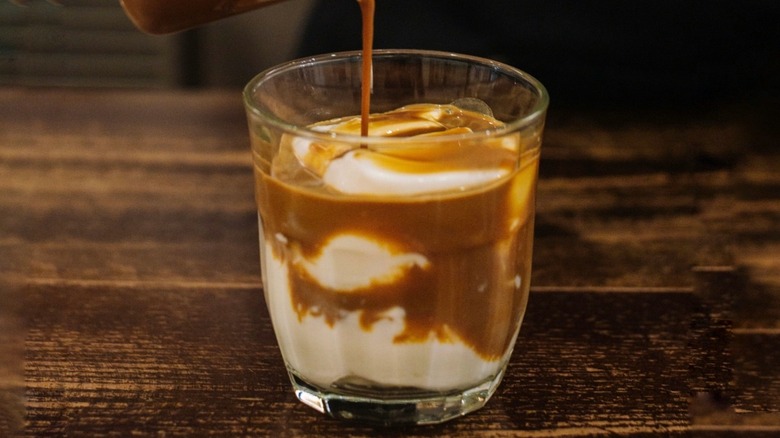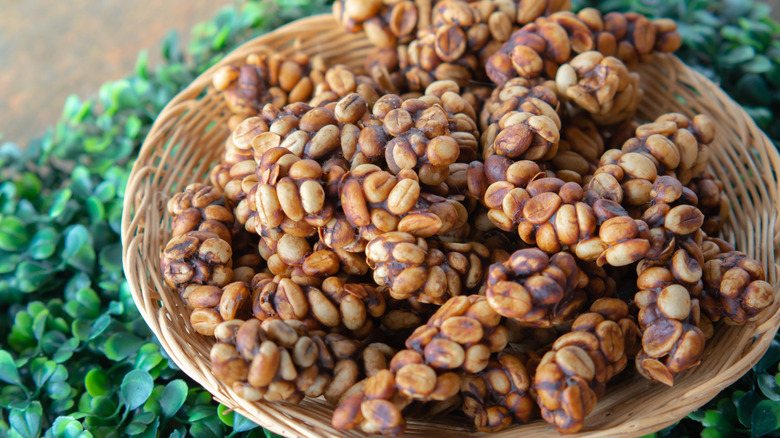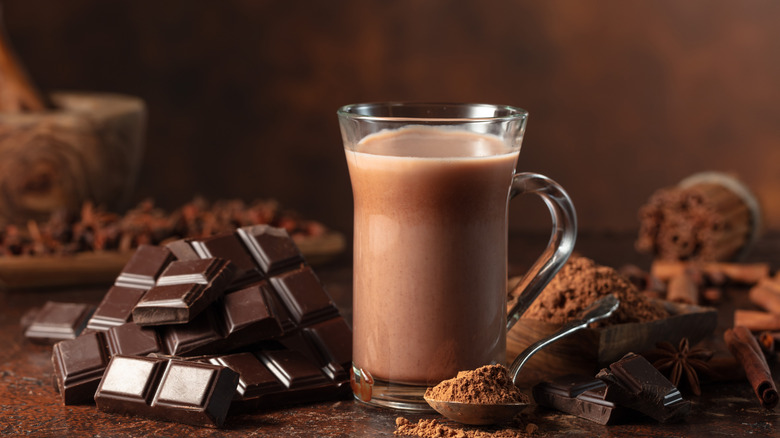10 Vietnamese Coffee Drinks That Are Definitely Worth A Try
Coffee culture in Vietnam may have originated from French colonization, but it has since morphed into something unmistakably Vietnamese. No matter which city in this vibrant country you find yourself in, cafes are as prevalent as bodegas in New York City. Locals relax on the street in low-to-the-ground chairs, sipping on earthy tea and cups of coffee at all hours of the night, watching the bustling city unfold in front of them.
An important part of both the culture and the economy, Vietnam is the world's second leading exporter of coffee behind Brazil. Each different region lays claim to its own specialty drinks that use unique flavors, textures, and ingredients to liven up the coffee experience in rousing ways. Venture outside of your go-to Americano or iced latte with this list of bold beverages that are easy to recreate in your own home.
If you prefer to order out, take a trip to the nearest Little Saigon or Vietnamtown — many major U.S. cities are home to enclaves of Vietnamese-Americans who share the diverse drinks and dishes of Vietnam in specialty grocers, restaurants, bakeries, and cafes. Put your nose to the ground in search of the fresh smell of coffee, or checkout your neighborhood Vietnamese restaurant and peruse the menu for a specialty drink.
Phin-filter black coffee
A basic cup of Vietnamese coffee is traditionally made with a Phin filter (although the bigger cafes are more and more using espresso machines to speed up the process). This small metal contraption is placed on top of a mug or cup, and the coffee is made in single servings that slowly drip out. It requires a bit more patience than pulling a shot from a European espresso machine, and it's truly representative of the mellow culture that surrounds coffee in Vietnam.
The beans used in Vietnamese coffee must be where Vietnam gets the reputation of having seriously strong coffee — robusta is the most frequently used, and it has about twice the caffeine content of the less common bean (arabica). Its high caffeine levels attribute to it having a more bitter and acidic flavor, which some may find off-putting (unless you love a strong cup of joe).
The less common bean, arabica, is perhaps only less common because it's much more difficult to grow. Bùi Thế Phương (he goes by Ben) of Nghệ Café told Chowhound, "Personally, I prefer Arabica for its delicate aroma, smooth texture, and subtle flavor." Ben sources arabica beans for his cafe in Ho Chi Minh City from his own coffee farm in the Central Highlands of Vietnam, where 80% of coffee grown in Vietnam originates from. If you're having trouble deciding on a bean, you can often find 50/50 blends that give you the best of both worlds.
Brown coffee
The Vietnamese name for brown coffee, cà phê sua dá, simply translates to "iced coffee," as it's the most common way for people to take their morning (or evening) cup. Brown coffee is aptly named for the color it takes on when you combine condensed milk with your morning brew. The unctuous sweet cream perfectly mellows out any bitterness and makes an enjoyably smooth cup of coffee.
The widespread use of condensed milk in Vietnam began when the French brought it over in the 19th century. Canned, condensed milk is much easier to transport and store than fresh milk when you don't have access to refrigeration, and this convenience has led to the silky sweet product being used in everything from smoothies to baked goods to coffee.
The Vietnamese have their own brand of condensed milk, called Vinamilk, that is produced in Vietnam and sold in large cartons. It might have a slightly different flavor than the small cans we're accustomed to in the U.S. simply because it's made from the milk of cows that are raised on different diets and in different climates than American cows. If you want an authentic experience, you might be able to find Vinamilk at a specialty grocer. If it's out of reach, don't let that stop you from grabbing whatever condensed milk you have available and mixing some in to your black coffee. Sip it hot or poured over ice and enjoy the smooth flavor of this enjoyable drink.
Silver coffee
This coffee is often served in a clear glass where its beautiful layers of color are easily visible. It's quite a straightforward operation: condensed milk and black coffee are combined along with a generous serving of fresh milk. The milk is either steamed hot enough that it becomes frothy on top, or poured over the top to be served cold. It's similar to a latte, although the addition of sweetened condensed milk makes it distinctly Vietnamese.
This drink was created and is still offered on many cafe menus for those who find a regular Vietnamese coffee too strong or too bitter, as the milk mellows out the whole drink and makes for a more pleasant sipping experience. Called cà phê bạc xỉu in Vietnam (although the name originates from Chinese) silver coffee is referred to in English as "silver" because of the pale color it takes on when the ingredients are mixed and combined. This drink is perfect for the days when you want your coffee to last a bit longer and go down smoother.
Salt coffee
The name sounds counterintuitive at first — who wants salt in their coffee? Don't worry, the salt doesn't go in the coffee itself but in the creamy, smooth layer of salted whipped cream that sits on top of brown coffee. This salty coffee, or cà phê muối, originates from Hue in Central Vietnam, a place also known for its magnificent street food and historical significance.
Chef Dieu Dinh of Dory's Cuisine Kollektive in Hanoi (the capital of Vietnam) shared her method for making this delicious drink that will leave you licking the rim and wishing for more. First, coffee is combined with condensed milk, mixed thoroughly, and poured over ice. It's then topped with a creamy whip made by combining a pinch of salt and a dash of milk with whipped cream. The milk ensures that the foam is perfectly light, slightly salty, and melts seamlessly into your coffee. The finishing touch is a sprinkling of cocoa powder or cinnamon over the top.
This coffee is often served with a spoon with the intent that you'll want to taste that silky cream and enjoy the flavor before mixing it into your coffee. It's just salty enough to intrigue your palate without making you thirsty, and it can easily be made in the comfort of your own kitchen.
Egg coffee
This stunning coffee is traditionally served in a porcelain cup that rests atop a candle stand, the flame gently heating your coffee and steaming the custard on top. It originates from the North of Vietnam where the weather is often much cooler and requires a comforting hot coffee to warm you up. Although, the popularity of this drink has made it readily available throughout the country.
This dessert-like drink, called cà phê trứng in Vietnamese, is made by whipping egg yolks with condensed milk, a pinch of sugar, and a few drops of vanilla extract until it's thick and creamy. If you don't have access to the candle-warming contraption, Lin Lou of Ninhie Coffee in Da Lat suggests warming your glass or mug in the microwave for 30 seconds before pouring in your black coffee, and finally topping it with even more egg cream and a sprinkling of cocoa powder or cinnamon. You can then place your coffee cup into a bowl of hot water to keep the custard warm and minimize the risk of food-borne illness from consuming raw egg yolks.
To enjoy this drink, taste the delightful custard with your spoon, and then sip the coffee so that the fluffy sweet topping mixes with bitter black coffee in one go. Lin Lou told Chowhound that he doesn't like to mix the two together, as it detracts from the thickness of the custard.
Coconut coffee
This eye-catching drink originates from the South of Vietnam where it is traditionally served ice cold, always there to assist you in beating the relentless and ever present Southern heat. Coconut trees are abundant in the South, and have come to influence much of the cuisine and culture in the surrounding area, leading to delicious products and dishes like this one. "Coconut is deeply rooted in daily life (in the South)," Ben of Nghệ Café in Ho Chi Minh told Chowhound. "From traditional meals to packaged products, coconut is an essential ingredient in the local cuisine."
This coffee is made by blending young coconut meat, coconut milk, a small amount of condensed milk, and ice cubes into a fresh, revitalizing mix which is poured into a tall glass and topped with black coffee or a shot of espresso. The blended mixture is often poured up high over the top of the glass, and it slowly melts into the coffee, making for a very Instagram-worthy presentation.
Ben says that, "It's best enjoyed cold, but if a customer prefers a hot version, we skip the ice and gently warm the coconut cream using the steam wand or a light heat before pouring in the espresso." He also prefers to use arabica beans in this drink for how their elegant flavor pairs with the coconut.
Yogurt coffee
This is a combination most of us would never think to try at home — yogurt is dolloped into a glass and topped with brown coffee and ice. Generally it's served with a spoon so you can taste the yogurt, which is tangy and thick like a Greek yogurt, but also sweet. Once you stir the yogurt and condensed-milk sweetened coffee together they become a filling drink that gives you a bit of nourishment along with the boost of energy. If you've ever put coffee in your morning smoothie, it's basically the same thing, simplified.
The yogurt used for this enjoyable twist on regular coffee is uniquely Vietnamese. Its sweetness, like many things in Vietnam, comes from condensed milk. Some cafes have their own recipes that call for condensed milk as one of the main ingredients, while others simply opt for Vinamilk yogurt to simplify the process. To recreate this drink at home, try a vanilla yogurt that's on the thicker side. Greek yogurt might be too tart and make for an unpleasant drink — opt for something sweeter instead.
Yogurt coffee, or sữa chua cà phê, originated in the capital of Vietnam (Hanoi) at one Cafe Duy Trí. They serve up an extra-thick yogurt coffee that's made with frozen yogurt, having an almost ice-cream like effect. If you want to give it a go, freeze your yogurt beforehand until it becomes thick and icy before pouring coffee over the top.
Weasel coffee
This infamous coffee gets its name not from some special strain of coffee bean, but from the weasel-like creatures who sniff out the best beans of the coffee plant, eat them, pass them through their digestive tract, and leave them behind still intact to be collected, washed, and turned into a drinkable cup of coffee. Yum, right?
This coffee, sometimes called Civet coffee or Kopi Luwak in other countries, is by far the most expensive coffee in the world, sometimes going for $300 per pound of beans. You might ask yourself, who was the first person to discover that the coffee beans in a weasel's pooh were still consumable? Like many things in Vietnam, this interesting invention came about from colonialism. The Vietnamese workers who tended the coffee farms owned by outside forces were banned from consuming the product they grew. They discovered that the beans left behind by the civets — or weasels — were actually quite delicious and consumable.
Given that weasel coffee has grown in popularity and become a sought-after bean, the farming practices for it are rather questionable — mass-production of ingredients doesn't usually bode very well for the animals required to produce them. Weasel coffee is no different, although there are a few brands that sell more affordable, "fake" weasel coffee, where the beans go through a fermentation process mimicking what occurs in the weasel's digestive tract without the nasty bits. This product is not only better for the weasels, it's also much more affordable.
Chocolate variations
If all of these drinks sound delicious to you, but you're just not much of a coffee drinker or can't have caffeine, don't worry — there are options. Vietnam's tropical climate lends to it being a good place to produce cocoa. It's a growing industry that is gaining more notoriety amongst chefs, with Marou chocolates playing a hand in the reputation of quality. These French transplants have started a thriving chocolate business that works directly with farmers to promote Vietnam's finest chocolate products.
Whether it's salt, egg, yogurt, or coconut coffee that you're longing to try, many cafes offer non-caffeinated versions that use cocoa in place of coffee. The cocoa is made with a blend of cocoa nibs, powder, and sugar or condensed milk combined with whole milk. You can order it hot (like a traditional hot cocoa) or on ice. From there they will top it with whatever flavor you desire, and you can enjoy the beverage just as you would the coffee version, sans caffeine.
